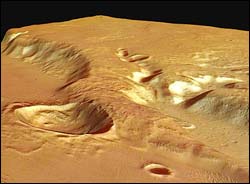This area deals with the fundamental laws and building blocks of nature and how they interact, the properties and the behavior of matter, and research into space and time and their structures.
innovations-report provides in-depth reports and articles on subjects such as astrophysics, laser technologies, nuclear, quantum, particle and solid-state physics, nanotechnologies, planetary research and findings (Mars, Venus) and developments related to the Hubble Telescope.

The NASA-led Swift mission has measured the distance to two gamma-ray bursts — back to back, from opposite parts of the sky — and both were from over nine billion light years away, unleashed billions of years before the Sun and Earth formed.
These achievements are the mission’s first direct distance, or redshift, measurements, its latest milestone since the Swift satellite’s launch in November 2004. The distances were attained with Swift’s Ultraviolet/OpticalTelesco

A UK-led team of astronomers has discovered a completely new type of star cluster around a neighbouring galaxy.
The new-found clusters contain hundreds of thousands of stars, a similar number to the so-called “globular” star clusters which have long been familiar to astronomers.
What distinguishes them from the globular clusters is that they are much larger – several hundred light years across – and hundreds of times less dense. The distances between the stars are, there

Achievement could benefit fields of superchemistry, quantum computing
A research team that in 2003 created an exotic new form of matter has now shown for the first time how to arrange that matter into complex molecules.
The experiments–conducted by Cheng Chin, now at the University of Chicago, and his colleagues under the leadership of Rudolf Grimm at Innsbruck University in Austria–may lead to a better scientific understanding of superconductivity and advance a grow

Data from ISO, the infrared observatory of the European Space Agency (ESA), have provided the first direct evidence that shock waves generated by galaxy collisions excite the gas from which new stars will form. The result also provides important clues on how the birth of the first stars was triggered and speeded up in the early Universe.
By observing our galaxy and others, scientists have long concluded that the explosion of massive stars like supernovae generates shock waves and

The last outstanding hardware needed before arrival of the Automated Transfer Vehicle (ATV), the European-built ISS supply ship due for launch in 2006, has been installed outside the International Space Station (ISS) during a 4 1/2 hour Extra Vehicular Activity (EVA) on Monday 28 March.
The two ISS Expedition 10 crewmembers, Commander NASA astronaut Leroy Chiao and Flight Engineer Russian cosmonaut Salizhan Sharipov, who was the operational lead for the EVA, installed the last t

These images, taken by the High Resolution Stereo Camera (HRSC) on board ESA’s Mars Express spacecraft, show part of the Medusa Fossae formation and adjacent areas at the highland-lowland boundary on Mars.
The HRSC obtained these images during orbit 917 with a resolution of approximately 13 metres per pixel. The scenes show an area located at about 5º South and 213º East.
The Medusa Fossae formation is an extensive unit of enigmatic origin found near the Martian ‘highlan